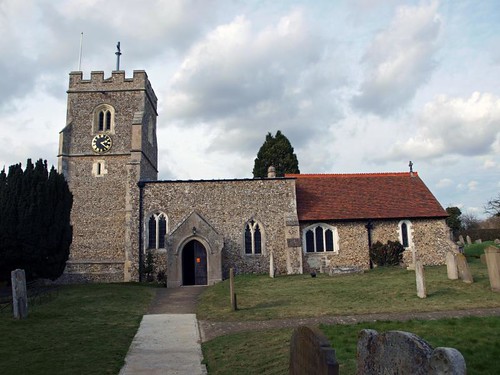ST MARY. Small flint church. W tower with diagonal buttresses, nave and long chancel. The latter dates from the C13 (see the windows on the N and S sides, the fragments of E windows replaced by a Perp window, and especially the double Piscina with pointed arches formed by the intersection of semicircular ones just as at Jesus College, Cambridge). The chancel N doorway was originally in the nave. Its date is C12, a date which is borne out by the nave Double Piscina. The windows of the nave C14- C15. The N aisle 1887. - SCREEN. C15; nothing special. - MONUMENT. Big epitaph to Mary Sparhauke d. 1770, by B. Palmer (classical with a crowning completely smooth and unadorned urn against a black obelisk).
Graveley. The Conqueror gave this village to his friend William Ewe, and the Normans built a church here. We find it up a country lane with two 17t.h-century farms and a few attendant cottages, while the rest of Graveley’s houses keep to the main road. Only the nave is left of the Norman church, and its doorway was removed to the chancel when the aisle was added last century. If we may judge by the beautiful double piscina this chancel must have been a lovely place when it was rebuilt in the 13th century. The chancel arch, its oak screen, and the nave roof are 500 years old. The modern pulpit has panels of carving a century older still. In the 15th-century tower hangs a bell made in 1589.
A short distance from this church a narrow road leads up to another which is now in ruins. Ivy clings to all that is left of its 600-year-old walls, and nettles and grass grow where men and women once knelt in prayer. Beside it is the manor house of Chesfield, still with its old boundary wall and the big chimney stacks which boldly proclaim its Stuart origin.
Flickr.
A short distance from this church a narrow road leads up to another which is now in ruins. Ivy clings to all that is left of its 600-year-old walls, and nettles and grass grow where men and women once knelt in prayer. Beside it is the manor house of Chesfield, still with its old boundary wall and the big chimney stacks which boldly proclaim its Stuart origin.
Flickr.

No comments:
Post a Comment